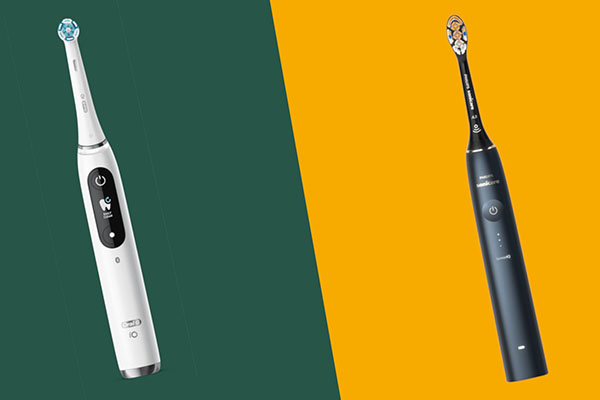Dozens of clinical trials show that electric toothbrushes provide a deeper and more effective cleaning than a manual toothbrush. While it may be a no-brainer to choose an electric brush over a manual, it can be difficult to know which brand to trust.
Sonicare and Oral-B are leaders in the electric brush market and for good reason. Both brands have been clinically proven to be effective in the fight against plague and gingivitis thanks to their unique technologies. While both perform similarly, each brand takes its own approach to bristle movement. Knowing more about the way these technologies work will provide consumers with the knowledge needed to choose the right brand for their next electronic brush. So, let’s start… Sonicare vs Oral B!
Sonicare Technology
Sonicare uses vibrating movement to provide teeth with a deep cleaning. Using patented technology, the brush can achieve 31,000 vibrations per minute and uses a sweeping motion to clean those hard to reach crevices of the mouth. The combination of the vibrating pulsations and sweeping movement dislodges plaqueand eliminates bio-film with relative ease.
While the brush may be powerful, it still provides a gentle cleansing that can reach between teeth and under the gum line. In fact, Sonicare brushes can remove up to four times more plaque than a manual brush. This results in a whiter smile after just a few weeks of use.
Oral B Technology
Classic Oral B electric toothbrushes use oscillating movement to clean teeth. Oscillating movement results in tens of thousands of strokes in just one minute, which is simply impossible to achieve with a manual one. The brand’s new Pulsonic line uses vibrations and a rotating head to provide a deep but gentle cleaning.
The combination of pulsating and oscillating movements is what makes the Oral B line so highly effective. Oral B brushes can achieve 27,000 vibrations per minute and its rotating head makes it easy to clean between teeth and other hard to reach places. Just like the Sonicare line of electric brushes, Oral B brushes are also capable of removing 4 times more plaque than a manual brush.
Sonicare vs Oral B
When shopping for an electric toothbrush, most consumers are curious about the differences between Oral B and Sonicare brushes. While there may be many brushes on the market today, these two brands are at the forefront of the market and have been for many years. Each brand has its own patented technologies that are backed by clinical studies and recommended by dentists all over the world.

Studies show that both Oral B and Sonicare are incredibly effective at removing plaque and the results are far superior to manual brushing. In the fight against periodontal disease, electric toothbrushes are the clear choice. Both brushes also come equipped with a number of features that help to make brushing more efficient and effective, such as timed brushing and different brushing modes.
The major difference between the two is bristle movement. Oral B’s classic line of brushes use oscillating movement to clean teeth. However, the brand has recently introduced their Pulsonic brushes that also include pulsations that are similar to Sonicare’s brushes.
- You want the most advanced electric toothbrush on the market.
- You want to have whiter teeth and healthier gums in just a couple of weeks.
- You want to have 5 different cleaning modes to choose from, for a personalized cleaning experience.
Conclusion
With both using similar technologies, it’s safe to say they both provide a deep and thorough cleaning. Each brand offers its own unique features and design, but ultimately, it’s all about personal preference.
Both Oral B and Sonicare have outstanding reputations and provide a high quality line of powered brushes that are built to last. If you’re still unsure of which brush to choose, we’ve reviewed the top models on the market to help you find the best one to meet your needs.
- Related post: Electric Toothbrush VS Manual Toothbrush : Pros and Cons




